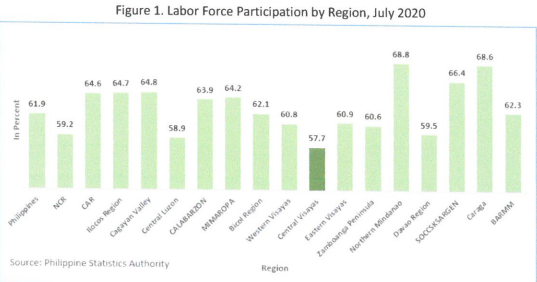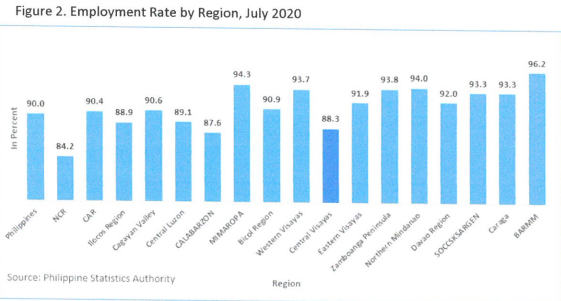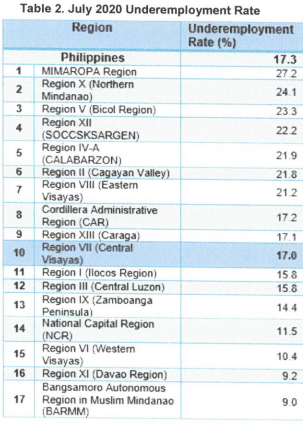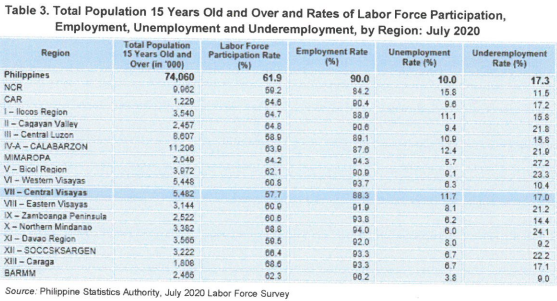Fifty-seven Percent of the population 15 years old and over are in the labor force
In July 2020, the total population 15 years old and over in Central Visayas was estimated at 5.48 million wherein the number of persons who were in the labor force was reported at 3.16 million. This placed the labor force participation rate (LFPR) at 57.7 percent, which means that six in ten of the population aged 15 years and over were either employed or unemployed. (Figure 1)

Central Visayas recorded an 88.3 percent employment rate
The total number of employed persons in Central Visayas was estimated at 2.79 million. The employment rate reported or the proportion of employed persons to total labor force was 88.3 percent (Figure 2).

Central Visayas had a lower employment rate than the national employment rate of 90.0 percent in July 2020.
Meanwhile unemployed persons include all those who, during the reference period, are 15 years old and over as of their last birthday who have no job/business, currently available for work and actively looking for work.
Also considered as unemployed are persons without a job or business who are reported not looking for work because of their belief that no work was available or because of temporary illness/disability, bad weather, pending job application or waiting for job interview.
Table 1 shows the national unemployment rate in July 2020 was estimated at 10.0 percent. The table also shows that there were 2 regions which have an unemployment rate higher than the Region VII figure.

By definition, employed persons who express desire to have additional hours of work in their present job, or to have additional job, or to have a new job with longer working hours are considered underemployed.
In July 2020, the underemployment rate was estimated at 17.3 percent for Central Visayas (Table 2) and ranked 10th among regions.

Underemployed persons who work for less than 40 hours in a week are called visibly underemployed persons.
The July 2020 Employment Situation is taken from the final result of the July 2020 Labor Force Survey conducted by the Philippine Statistics Authority (Table 3).

TECHNICAL NOTES
The Labor Force Survey (LFS) is a nationwide quarterly survey conducted by the Philippine Statistics Authority (PSA) during the months of January, April, July, and October. For this release, the data being presented are based on the final results of the April 2020 round of the LFS.
The reference period used in the survey is the past seven (7) days preceding the date of interview of the enumerator.
The concepts and definitions used in the survey can be found in PSA Integrated Survey of Households (ISH) Bulletins. Some are given below:
a. Barangay – is the smallest political subdivision in the country, several of which comprise one city or municipality. For purposes of enumeration in the LFS, a barangay is considered the basic geographic enumeration area.
b. Household – refers to an aggregate of persons, generally but not necessarily bound by ties of kinship, who sleep in the same dwelling unit and have common arrangements for the preparation and consumption of food. Members comprise the head of the household, relatives living with him, and other persons who share the community life for reasons of work or other consideration. A person who lives alone is considered a separate household.
c. Reference Period – reference period for this survey is the “past week” referring to the past seven (7) days preceding the date of visit of the enumerator or interviewer.
d. Labor Force – refers to the population 15 years old and over who contribute to the production of goods and services in the country. It comprises the employed and unemployed. Overseas workers are excluded in the estimation of the size of working population (population aged 15 years and over) since the data on their economic characteristics are not collected because they are not considered part of the labor force in the country.
e. Employed – refers to persons in the labor force who are reported either as at work or with a job or business although not at work. Persons at work are those who did some work, even for an hour during the reference period. With a job but not at work refers to those who have job or business but are not at work because of temporary illness or injury, vacation or other reasons. Likewise, persons who expect to report for work or to start operation of a farm or business enterprise within two weeks from the date of the enumerator’s visit are considered employed.
f. Unemployed – refers to persons in the labor force who are reported as:
1. without work;
2. currently available for work; and
3. seeking work or not seeking work due to the following reasons:
i. ECQ/Lockdown/COVID-19 pandemic;
ii. Belief that no work is available;
iii. Awaiting results of previous job application;
iv. Because of temporary illness or disability;
v. Bad weather; or
vi. Waiting for rehire or job recall.
g. Underemployed – refers to employed persons who express the desire to have additional hours of work in their present job or an additional job, or a new job with longer working hours. Visibly underemployed persons are those who work for less than 40 hours during the reference period and want additional hours of work.
h. Labor Force Participation Rate (LFPR) – refers to the proportion of total labor force to the total household population 15 years old and over.
i. Employment Rate – refers to the proportion of employed persons to the total labor force.
j. Unemployment Rate – refers to the proportion of unemployed persons to the total labor force.
k. Underemployment Rate – refers to the proportion of underemployed persons to total employed persons.
l. Determination of Employment Status
The employment status of persons 15 years and over is determined on the basis of answers to a series of inter-related questions which are described below:
1. “Did____ do any work at all even for only one hour during the past week?” This question is asked to identify the employed persons. “Work at all” for purposes of this survey means that a person reported to his or her place of work and performed duties or activities for at least one hour during the reference week. If a person reported that he or she did some work, not counting chores around the house, the person is still considered in the employed category although most of his or her time was devoted to household chores. All persons not identified as employed in the above question are asked the following questions.
2. “Although ____ did not work, did ____ have a job or business during the past week?” Some persons may not have worked at all during the past week but may actually have jobs or businesses on which they are temporarily not reporting to, as in the following cases: an employee on strike; a person temporarily laid off due to non-economic reasons like machine breakdown; a person with a new job to begin within two weeks from the date of interview; and regular and temporary teachers during summer vacation, excluding substitutes, who still receive pay and are expected to go back to their jobs in the next school year. These persons are considered employed even though they are not actually at work.
3. “Did ____ look for work or try to establish a business during the past week?” This question is asked to determine who among those who had no job or business had really done something to look for work. If a person looked for work and is reported as currently available for work, he or she is classified as unemployed. Otherwise, if a person is not currently available for work, the next
m. Old Definition of Unemployment - The old definition considered a person unemployed if he or she has no job or business during the reference period and is actively looking for work. Also considered as unemployed are persons without a job or business who are reported not looking for work because of the belief that there is no work available, or because of temporary illness or disability, bad weather, pending job application, or waiting for job interview.
n. Work - Work means any economic activity a person does for pay during the past week, in cash or in kind, in any establishment, office, farm, private home, or for profit; or without pay on a family farm or enterprise. It also includes the activities engaged in by a farm operator or member of the operator’s family, on the farm operated by another household on exchange labor arrangement.
In addition, any activity that a person does during the past week in relation to minor activities in home gardening; raising of crops, fruits, hogs, poultry and others; fishing for home consumption; and manufacturing for own use, are also considered work. However, for these activities to be considered work there must be some harvest in the case of home gardening, raising of crops, fruits and nuts, and gathering of wild fruits and vegetables; animals disposed of (sold, consumed, bartered or given away); or some catch in fishing.
o. Occupation and Industry - The data on occupation and industry relate to the job held by employed persons during the past week. Occupation refers to the specific kind of work a person does, while industry refers to the nature or character of the business or enterprise or the place where a person works. Persons employed in two or more jobs are reported in the job: (1) that is permanent, whether full time or part time; (2) where they worked more hours, if all are permanent jobs; or (3) where they derive more income, if all are permanent jobs with equal hours of work.
p. Class of Worker – Employed persons are classified according to seven categories namely:
1. Worked for Private Household – These are employed persons working for pay in a private household, in cash or in kind. Examples are domestic helper, household cook, gardener, and family driver.
2. Worked for Privates Establishment – These are persons working for pay in a private establishment, in cash or in kind.
3. Worked for Government and Government-Controlled Corporation – These are persons working for the Philippine government or a government corporation or any of its instrumentalities.
4. Self-Employed – these are persons who operate their own businesses or trades and do not employ paid workers in the conduct of their economic activities.
5. Employers – These are persons who employ one or more paid employees in the operation of their businesses or trades. Thus, domestic helpers, family drivers and other household helpers who assist in the family-operated business, regardless of time spent in this activity, are not hired employees in the enterprise/business. A farm or business proprietor who is assisted by such domestic help is not also considered an employer.
6. Worked with pay in own family-operated farm or business – these are members of the household who receive cash, or fixed share of the produce, as payment for their services in a farm or business operated by another member living in the same household.
7. Worked without pay in own family-operated farm or business – these are members of the household who assist in the operation of own family-operated farm or business, and do not receive any wage or salary for their work. The room and board and any cash allowance given as incentives are not counted as compensation for these family workers.
q. Number of Hours Worked – refers to the actual number of hours engaged in by a person in all the jobs or businesses that he or she held during the past week. It includes the duration or the period when the person was occupied with his or her work, including overtime, but excluding hours paid but not worked. The normal working hours per day is the usual or prescribed working hours of a person in his or her primary job or business which is considered a full day’s work.
r. Averages – the averages shown in this report are arithmetic means.
s. Rounding of Estimates – individual figures are independently rounded to the nearest thousands; hence, group totals may not always be equal to the sum of the individual figures.
t. Comparability with Related Data – the information presented here are obtained from sample households. Differences observed among corresponding figures obtained from a complete count or another independent survey using the same schedules and instructions are due to sampling variations and other biases not attributable to sampling. Due to the difference in primary sampling units, the employment data obtained from household surveys may differ from employment data based on reports from establishment surveys.
Notes:
1. Starting January 2012 LFS, the codes for industry adopted the 2009 Philippine Standard Industrial Classification (PSIC). Prior to this, codes for industry used the 1994 PSIC.
2. Starting April 2012 LFS, the codes for industry adopted the 2009 Philippine Standard Industrial Classification (PSIC). Prior to this, codes for industry used the 1994 PSIC. Further, question on vocational course was also introduced in the April 2012 LFS questionnaire. In addition, the 2012 Philippine Standard Occupational Classification (PSOC) was adopted starting April 2016. The 1992 PSOC had been used prior to this round. Question on vocational course was introduced in the April 2012 Labor Force Survey (LFS) questionnaire.
3. Starting April 2016 round, the LFS adopted the 2013 Master Sample Design, with a sample size of approximately 44,000 households.
4. The 2012 Philippine Standard Occupational Classification (PSOC) was adopted starting April 2016. The 1992 PSOC had been used prior to April 2016.
5. Starting with the April 2016 LFS round, the population projections based on the 2010 Census of Population and Housing (2010 CPH) has been adopted to generate the labor force statistics.
6. In July 2016, the 2008 Philippine Standard Classification of Education (PSCED) that was used in the 2015 Population Census (2015 POPCEN) has been adopted. The categories in highest grade completed were also revised considering the K-12 program in the education system.
7. In April 2017 round, Computer Aided Personal Interviewing (CAPI) using Tablet was utilized in the LFS enumeration.
8. Overseas Filipino Workers (OFWs) are not considered as part of the labor force in the Philippines. Hence, in the LFS, data on economic characteristics of household members who are OFWs are not collected. For the LFS reports, they are excluded in the estimation of the size of working population, that is, population aged 15 years and older, and in the estimation of the labor force.
9. In January 2019, the 2017 Philippine Standard Classification of Education (PSCED) has been adopted. The categories for highest grade completed were also revised considering the K to 12 program in the education system.
10. Starting with the January 2020 LFS round, the population projections based on the 2015 Population Census (POPCEN 2015) have been adopted to generate the labor force statistics. For comparability, population projections based on the POPCEN 2015 were likewise used in the April 2019 labor force statistics.
10. For the July 2020 round, ECQ/Lockdown/COVID-19 pandemic was included in the reasons for working more than 48 hours, less than 40 hours, and not looking for work.
Approved by:
ARIEL E. FLORENDO
Regional Director

